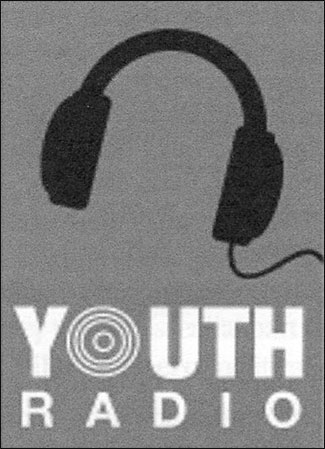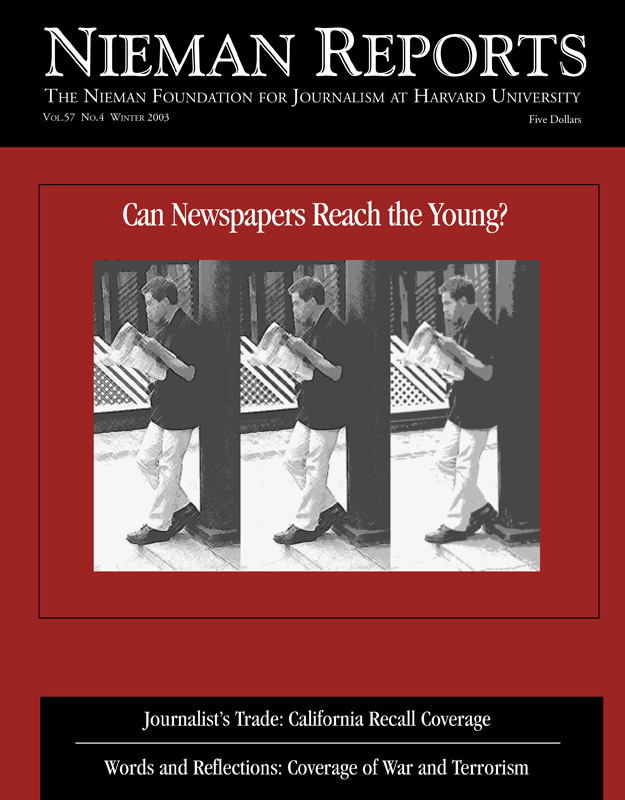Youth Radio trains young people to become journalists and to produce content for a variety of audiences, in formats including newspapers, TV, radio and the Web. In our decade plus of operation, we have found that having young people as the voices and writers, as the producers and columnists of what is produced, might initially attract a young audience. But without something compelling to say, listeners won’t stick around. And to engage young audiences, we employ their vernacular and style.
In the Youth Radio newsroom, a frequent challenge—as adult mentors—is to follow the young producers’ advice, especially when we’re not sure they’re right. For example, for three years, Youth Radio produced a public affairs show on the largest commercial music station in San Francisco, KYLD. This was a great opportunity for our kids’ work to reach a young audience since this was the number one station in the Bay Area among 14- to 24-year-olds. Our young producers insisted music should play for the entire two-hour show, as a continuous sound under the features, interviews and even the call-ins. To the adult ear, the music was distracting; it made it difficult to listen to what was going on in the show. But the kids told us that “it’s the music that keeps young people listening to the talk, it makes the news and information painless.”
We deferred to the students since they were familiar with the station’s programming from the perspective of listeners. And it turns out they were right. For a public affairs show to last three years on commercial radio is the equivalent of three lifetimes elsewhere. KYLD’s program director, Michael Martin, credited Youth Radio’s highly produced style and “the use of music” for the show’s longevity. Martin commented that most public affairs shows jolt his station’s listeners with an immediate break in format, a mortal sin in commercial broadcasting.

Youth Plus Experience
Youth Radio students often remind us that teenagers and young adults don’t usually think of themselves as part of a particular audience. Rather they describe themselves as avid consumers or media surfers on an infinite ocean of content. For many, this expectation can be traced back to MTV, which began some 20 years ago. Having the ability to choose from an ever-expanding array of media content has defined this generation—just as “I Love Lucy” and “Leave It to Beaver” left their indelible mark with baby boomers.
RELATED ARTICLE
“Why I Don’t Like Mainstream News”
– Youth Radio’s student journalistsYoung writers and producers not only present the views of their generation, but they also identify stories and produce them with distinctive youth style. In the fall of 2002, for example, newsrooms throughout the Bay Area, including Youth Radio, were struggling with how to cover the record youth homicide rate, high in many urban areas, but particularly so in Oakland. Many of our Youth Radio students live in the affected neighborhoods; one of our own students was shot and killed, and others have relatives lost in the madness. Local news outlets were tired of covering the story; the deaths of young people became routine headlines along with increasing body counts. Our national editors weren’t sure we “had anything new to say” from the youths’ perspective.
In the Youth Radio newsroom our students were also hesitant to report on this very painful issue until one of our adult producers, Lissa Soep, added the element of poetry to the production. A poem written by 19-year-old Ice Life told the story of a modern day Romeo and Juliet caught in the cycle of poverty and violence that so often leads to incarceration and death. This poem inspired the students to produce a feature that integrated poetry with field recordings and interviews with young people living in these neighborhoods. The sound collage also included the perspective of youth who have escaped the cycle of violence by keeping a pathway to education and a career.
The Oakland violence feature these Youth Radio students produced was a hit locally with both adult and youth audiences. It also was broadcast on National Public Radio, after we “shopped it around” and found a producer, Charlie Mayer, who was as excited as we were about the artistic and journalistic merits of the piece. “Oakland Violence” won first prize in this year’s National Black Journalists Awards and was honored this year at the Third Coast Festival.
Collaboration and Authenticity
Youth Radio’s success with mainstream media outlets is built on this kind of collaboration. And to do this successfully requires balancing young producers’ insights and new ideas about content with the professionalism and knowledge of their adult counterparts. At Youth Radio, youth and experienced staff producers work together throughout the editorial process. We set the highest standards of quality, explaining to the students that programming by and about youth must be better than first-rate to compete in today’s very competitive media markets. With this emphasis on journalistic quality and cutting-edge youth style, Youth Radio is in the fortunate position of receiving assignments from major news organizations including National Public Radio, the San Francisco Chronicle’s opinion section, Public Radio International, Marketplace and CNN.com.
Because Youth Radio’s goal is to bring diverse voices to the largest and most diverse audiences possible, we produce lots of different kinds of programming. Our presentations run from one minute to two hours; they involve music, commentary and features as well as talk shows; they appear mostly on radio (public and commercial), but also through the Web, TV and in print.
Youth Radio’s senior producer, Rebecca Martin, believes audiences respond to our programs because of “the unique sensibility that young people bring to their reporting, giving audiences access to perspectives, truths and trends that adult reporters just can’t reach.” When a Youth Radio reporter did a bedside interview with a U.S. soldier who lost a leg in a battle in Iraq, the soldier’s comments are revealing; what comes through is the sense that this soldier is especially at ease with the approach of a reporter who is just about his own age.
Youth Radio’s production and editorial process becomes longer and a bit rockier (not to mention more fun!) because of the side-by-side work of the youth-adult team. If young people collected the tape, then handed it over to adult professionals to write and produce, getting the pieces broadcast would no doubt be easier. The “youth-only” and the “adult-only” producer models each have value and are critical models in expanding the involvement of youth voices. But we find that the collaboration brings excitement and authenticity to the work. For Youth Radio, collaboration is the way to go because of our commitment to training the next generation, who reflect a diversity of economic and ethnic backgrounds.
Ellin O’Leary is president and executive producer of Youth Radio, an award-winning youth media organization, founded in Northern California in 1990 and with bureaus in Los Angeles, Atlanta and Washington, D.C.


